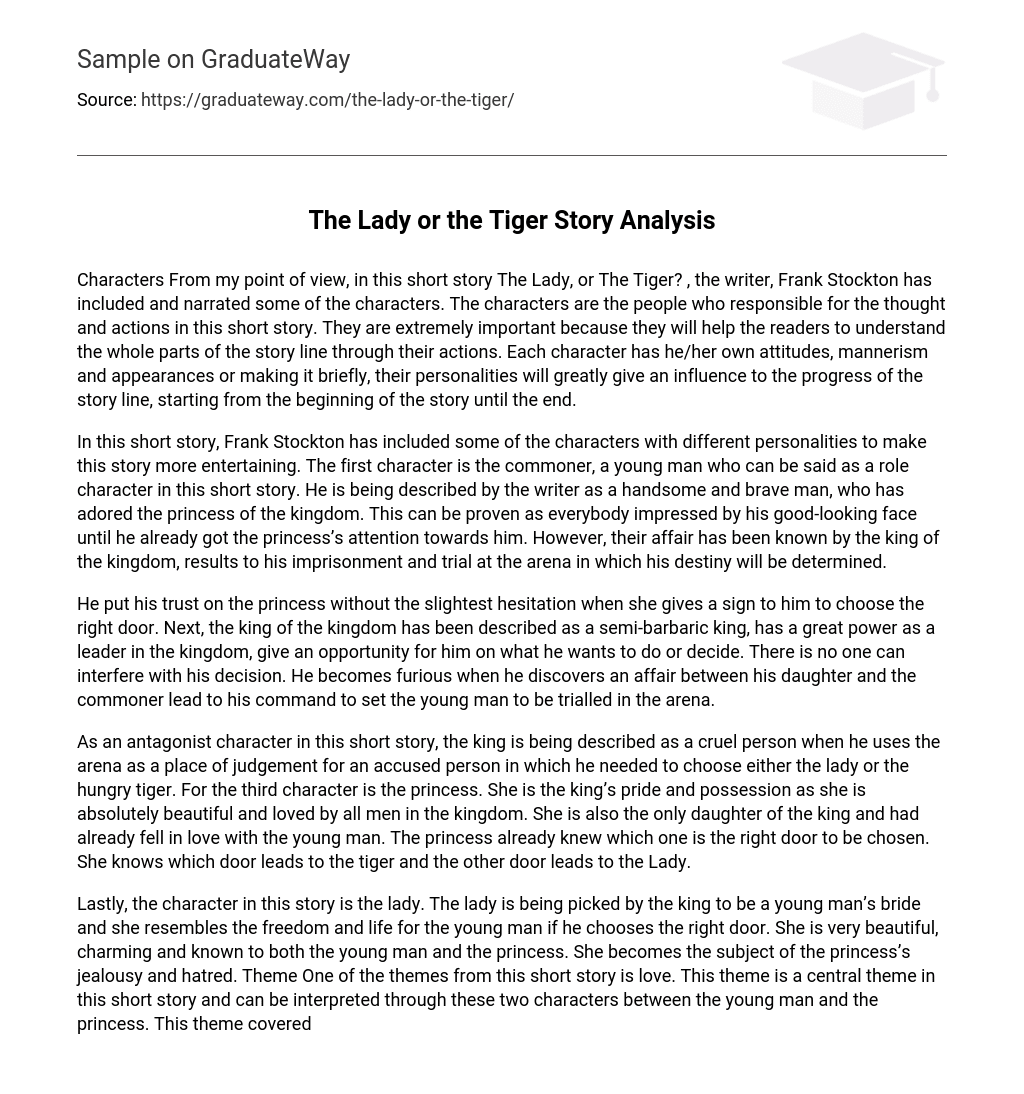Frank Stockton, the author of The Lady, or The Tiger?, incorporates and describes multiple characters in this short story. These characters are crucial as they are responsible for the thoughts and actions depicted throughout the narrative. Their importance lies in helping readers understand the entire plot through their actions. Each character has their own distinct attitudes, behaviors, and appearances—or personalities—that significantly influence the development of the story from start to finish.
Frank Stockton’s short story incorporates characters with diverse personalities to enhance entertainment value. One noteworthy character is the commoner, a young man who plays a pivotal role in the narrative. The author portrays him as a handsome and courageous individual who admires the princess of the kingdom. This is evident as he captivates everyone with his attractive appearance, eventually catching the princess’s eye. Unfortunately, their relationship is discovered by the king, resulting in the commoner’s imprisonment and an ensuing trial in the arena, where his fate hangs in the balance.
When the princess signaled to him, he trusted her without any hesitation to select the correct door. The king of the kingdom, described as a partially uncivilized ruler, holds immense influence and grants himself the freedom to make choices and decisions. No one is allowed to intervene in his judgment. Upon learning about his daughter’s romantic involvement with a commoner, he becomes filled with anger and orders that the young man be put on trial in the arena.
The king, depicted as a cruel antagonist in this short story, passes judgment on an accused person using the arena. Within the arena, he faces the decision of choosing either the lady or the hungry tiger. The princess, introduced as a beloved possession of the king and adored by all men in the kingdom for her beauty, is also his only daughter. She has already fallen in love with a young man and possesses knowledge about which door leads to the tiger and which door leads to the lady.
To summarize, the lady in this narrative represents freedom and life for the young man as she becomes the king’s bride. Both the young man and princess are aware of her beauty and charm, resulting in jealousy and hatred from the princess. Love is a prominent theme throughout the story, particularly evident in the relationship between the young man and princess. This theme pervades the entire narrative.
Initially, the king discovers the forbidden love between the young man and the princess. Consequently, the young man is confined and subjected to a trial within the arena. This tale also delves into authority, showcasing how specific individuals possess immense power. It illustrates that despite the absence of external factors, only one person in the kingdom wields influence over the king’s choices and directives while everyone else unwaveringly obeys without hesitation.
The king’s authority is absolute, and he exercises it without question. He possesses the privilege of determining who will face a trial in the arena when accused. Once brought to the arena, the young man is denied any opportunity to defend himself or provide an explanation. This highlights the king’s extensive control over his subjects. Moreover, jealousy emerges as a prevalent theme in this scenario. The princess experiences feelings of despair and envy due to her profound affection for him; she does not desire his demise. However, if he were to choose life, she also harbors intense jealousy towards the woman who would become his partner, consequently fostering hatred within the princess.
The writer does not reveal the resolution of the short story. It is uncertain if the princess will overcome her jealousy and accept the lady’s relationship with the young man, or if she will let her jealousy lead to his demise. Her jealousy will influence the outcome of the story. The story also explores social status as a theme, which is evident from the beginning when the writer portrays the kingdom’s atmosphere and scenery, emphasizing the social divide between the royal family and commoners.
The relationship between these two groups is strictly prohibited because it would harm the reputation of the royal family. As a result, the young man is currently being tried in the arena as his punishment since the king discovered his love affair with the princess. Additionally, this short story showcases loyalty, particularly blind loyalty, as another theme. This theme becomes prominent when the young man is accused and slated for trial. Despite the situation, he stays loyal to the king’s orders without any doubts or objections.
Despite being aware of the unfairness towards the young man, the people remained loyal to their king and unquestioningly obeyed his commands. The arena, a significant symbol, represents a place where individuals accused of crimes face judgment to determine their guilt or innocence. Those found guilty are promptly punished while those found innocent receive rewards whether they desire them or not. There is no escape from the king’s judgments as represented by this arena. Another crucial symbol is the king himself.
The king represents absolute power, with his commands and words serving as unquestionable laws. The people obediently follow him without question. Another symbol is the young maiden, who represents life and freedom for the young man. If he chooses the correct door, he will marry her immediately as a reward. However, the tiger symbolizes death and guilt for the young man. If he chooses the wrong door, he will be killed and devoured by the tiger, proving his own culpability according to his fate.





